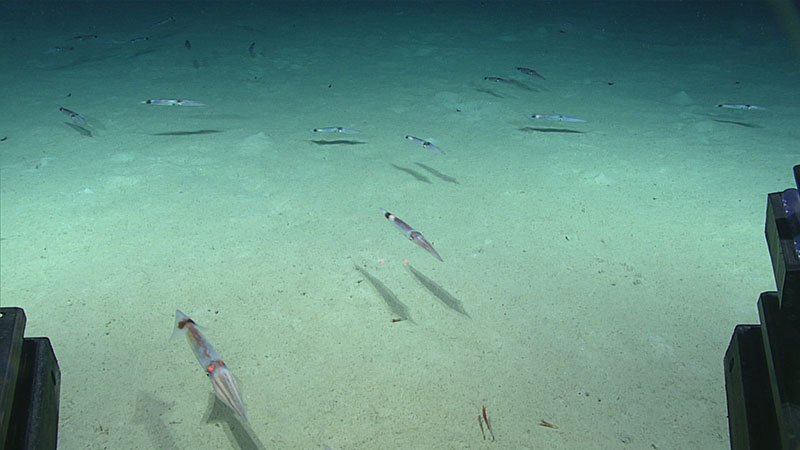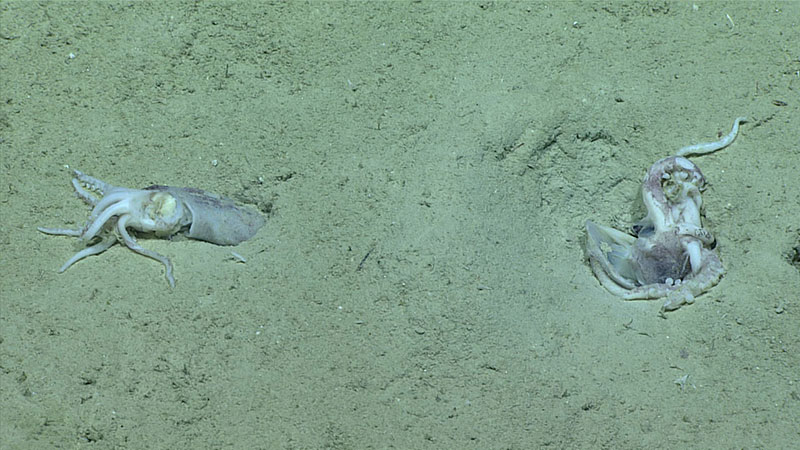
By Mike Vecchione, NOAA National Marine Fisheries Service National Systematics Lab, National Museum of Natural History
December 2, 2017

Large numbers of these squid were seen near the seafloor throughout the dive. Image courtesy of the NOAA Office of Ocean Exploration and Research, Gulf of Mexico 2017. Download larger version (jpg, 740 KB).
What kind of event? Good question. First, let’s consider what type of squid, because that helps answer the question of what kind of event.
The first dive by remotely operated vehicle (ROV) Deep Discoverer (D2) during Okeanos Explorer’s 2017 exploration of the Gulf of Mexico targeted the continental slope near Key West, Florida, where relatively shallow waters near land drop off into the deep sea.
When the ROV reached the seafloor at 815 meters (2,674 feet) depth, it came down in a large group of squid. They were muscular and not as strange looking as many deep-sea squids. For someone who studies squids, it was pretty obvious that these squids belonged to the family Ommastrephidae, the “flying squids.” Their appearance and behavior was fairly typical of shortfin squids in the ommastrephid genus Illex.
Identification to the species level is tricky because there are three Illex species in the Straits of Florida and they are very difficult to tell apart. Essentially, the only way to be certain of the species is if you have a mature male specimen and can closely examine the modified arm that he uses to transfer sperm packets to the females or if you can sequence the squid’s DNA.
Fortunately, for visual observations in the natural habitat like these, you can make an educated guess based on relative body proportions. Because these squid had narrow bodies, large heads and arms, and sharply pointed fins, I think they were a poorly known species named Illex oxygonius, the sharptail shortfin squid. This species was first described from this geographic area. Coincidentally, I participated in a trawling study in 2010 very close to the Okeanos dive site during which we caught several hundred Illex, most of which were mature I. oxygonius males. Therefore, I think that the many squid seen by D2 were sharptail shortfin squid.

Many of the dead squid we observed during the dive appeared to have been pulled into burrows. Image courtesy of the NOAA Office of Ocean Exploration and Research, Gulf of Mexico 2017. Download larger version (jpg, 1.0 MB).
The squids were so numerous that at times as many as 40-50 were in the camera’s field of view at once. It is not unusual to see large schools of shortfin squid. What was remarkable was that D2 came across dozens of dead squid lying on the bottom.
Because many scavengers, including fishes, decapod crustaceans, and giant isopods, were also seen in the area, and because a dead squid makes a very good meal in the normally food-poor deep sea, it is likely that squid bodies do not last long before being eaten. The dozens of squid corpses we saw thus represented a much larger number dying in the area. D2 recorded video of a crab eating one of the squid. Close-ups by D2’s cameras showed that, although most squid appeared active and displaying typical color patterns, some of the squid were in poor condition.

A crab feasts on a squid. Image courtesy of the NOAA Office of Ocean Exploration and Research, Gulf of Mexico 2017. Download larger version (jpg, 1.2 MB).
This was clearly a mass-mortality event. We used to think that squids mate, spawn once, and then die. That idea was based on observations of a few species convenient to marine-science labs. As we have learned more about life in the deep sea, we have found that pattern to be an oversimplification. However, there is evidence that it is the pattern for shortfin squids.
At least one D2 sequence showed one squid grab another, which could have been a mating attempt. While we did not see any females laying their large floating gelatinous egg masses, I think our observations are consistent with communal mating and spawning. My best guess is that D2 landed in the middle of a terminal reproductive event for these squid.
Regardless, these squid are very important as both predators and prey in the open ocean of the Gulf of Mexico and western North Atlantic. The numerous squid bodies certainly provide an important, although ephemeral, food subsidy to the benthic (bottom-living) ecosystem in this area.
As an aside, some readers may wonder about my use of “squid” versus “squids” as a plural. I follow the same system used by fish biologists. When discussing multiple members of a single species, we say squid (or fish, as in, “these fish are very tasty”), but when referring to more than one species, the word would be squids (or fishes, as in, “the fishes of the Gulf of Mexico”).
Roper, C.F.E., C. C. Lu, and M. Vecchione. 1998. Systematics and distribution of Illex species; a revision (Cephalopoda, Ommastrephidae). In: Voss, N.A., et al. (eds.) Systematics and Biogeography of Cephalopods. Smithson. Contr. Zool. 586:405-423.
Carlini, D.B., L.K. Kunkle, and M. Vecchione. 2006. A molecular systematic evaluation of the squid genus Illex (Cephalopoda: Ommastrephidae) in the North Atlantic Ocean and Mediterranean Sea. Molec. Phylog. Evol. 41:496-502.
Harrop, J., M. Vecchione, and J.D. Felley. 2014. In-situ observations on the behavior of the ommastrephid squid genus Illex in the northwestern Atlantic. J. Nat. Hist. 48(41-42):2501-2516. online version http://dx.doi.org/10.1080/00222933.2014.937367
Judkins, H, S. Arbuckle, M. Vecchione, L. Garrison, and A. Martinez. 2015. Cephalopods in the potential prey field of sperm whales (Physeter macrocephalus) in the northern Gulf of Mexico. J. Nat. Hist. 49(21-24):1267-1280. online version http://dx.doi.org/10.1080/00222933.2013.802045